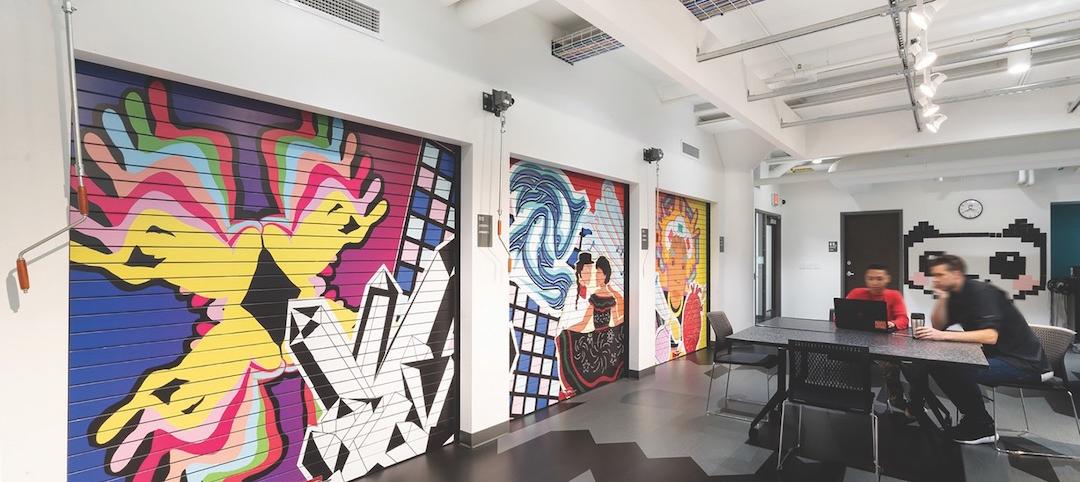A team of alumni from the NewSchool of Architecture and Design in San Diego has taken over a 28,500-sf empty city block in that metro to create what they hope will be a revenue-generating urban park that, when it opens on March 5, includes food service, retail, performance and meeting spaces, and a dog park.
The urban park, called Quartyard, was funded partly by local residents through a Kickstarter campaign that raised $60,000 from 300 donors in 30 days. All told, Research Architecture Development Laboratory (RAD Labs) has $500,000 invested in this venture, according to its 29-year-old CEO Philip Auchettl, who formed the company with NewSchool classmates David Loewenstein, who is RAD Labs’ COO; and Jason Grauten, a partner. The park, in fact, started out as their college thesis project. (The company’s CFO, Adam Jubela, has a degree in entrepreneuriship and finance from the University of Arizona.)
Originally, Auchettl tells BD+C, RAD Labs’ plan was to install “pop-up” structures on the lot. “But then we asked ourselves why properties like these were vacant in the first place.” His team concluded that there was nothing to draw people or businesses to the site. So RAD Labs decided to “activate” the lot temporarily, “as a placeholder for future expansion.”
RAD Labs has already tested its “activation” strategy, as a way of drawing people to a site, with a 12-month installation at another empty lot, which used 300 recycled pallets for benches and tables. The site is next to a coffeehouse, “which encourages people to walk in and use the space,” says Auchettl.
After meeting with former Mayor Bob Filner and the city’s attorney, RAD Labs agreed to lease the vacant block for Quartyard for two years, with a 12-month extension. The city’s development arm, Civic San Diego, eventually intends to build high-rise housing on this site, although no timetable has been set, and this block has been vacant for a number of years.
(The San Diego Union-Tribune reports that RAD Labs is paying the city $1 per year for the lot, and will split any profits with the city and its financial partners. Auchettl tells BD+C that local residents and students “who wanted to become part of something different and exciting” are also investors. He did not disclose any names.)
As of last week, Quartyard had three permanent vendors: Best Beverage Catering, which will run a beer garden (hence the park’s name); a mini coffee shop, and a restaurant called S&M Sausage & Meat. Auchettl says that when the park opens it will offer a series of food trucks that might change from day to day; an area where concerts, meetings, and private dinners can be held; and a dog park, which should be a big hit in downtown San Diego where “there seem to be more dogs than people,” he quips.
Vendors will set up in 14 recycled shipping containers around the periphery of the park. They purchase and refurbish the containers and lease their space. Auchettl says his team was drawn to the “simplicity” and portability of the containers, which have become popular components in the urban “cargotecture” movement that has sprung up in different parts of the country.
Auchettl says his company—located in offices at NewSchool, a few blocks from Quartyard—isn’t trying to reinvent the wheel. “But an urban park today can’t just be a few benches and trees. Now, it has to be an activity space.”
Related Stories
Cultural Facilities | Sep 24, 2020
America's 11 most endangered historic places - 2020 list
Annually, this list spotlights important examples of our nation’s architectural and cultural heritage that, without applied action and immediate advocacy, will be destroyed or face irreparable damage.
Giants 400 | Aug 28, 2020
2020 Giants 400 Report: Ranking the nation's largest architecture, engineering, and construction firms
The 2020 Giants 400 Report features more than 130 rankings across 25 building sectors and specialty categories.
Cultural Facilities | Jun 19, 2020
A new ULI report chronicles the depaving of America
Fifteen examples of how parks and green spaces emerged from parking lots, garages, and underpasses.
Libraries | Jan 23, 2020
Information or community center: The next generation of libraries must be both
Are libraries still relevant in a digital world?
Cultural Facilities | Dec 4, 2019
Snøhetta wins competition to design maritime center in Esbjerg, Denmark
The project’s design was developed with WERK Arkitekter.
Cultural Facilities | Dec 1, 2019
Small-venue theaters play starring cultural and economic roles in New York City’s economy
A new study identifies the challenges these theaters face, and offers possible solutions that include more city support.
Cultural Facilities | Nov 11, 2019
‘The Whale’ will be an arctic attraction 185 miles north of the Arctic Circle
Dorte Mandrup won an international competition to design the project.
Cultural Facilities | Nov 1, 2019
Coldefy & Associés’ design selected for Pulse nightclub shooting memorial
The design was selected from 68 entries.
Cultural Facilities | Oct 29, 2019
A watchtower in Harlem, once a firefighter’s lookout, is restored as a landmark
The nearly $8 million project required major structural interventions.
Giants 400 | Oct 3, 2019
Top 65 Cultural Sector Construction Firms for 2019
Whiting-Turner, Turner, PCL, Clark Group, and Gilbane top the rankings of the nation's largest cultural facility sector contractors and construction management firms, as reported in Building Design+Construction's 2019 Giants 300 Report.

















